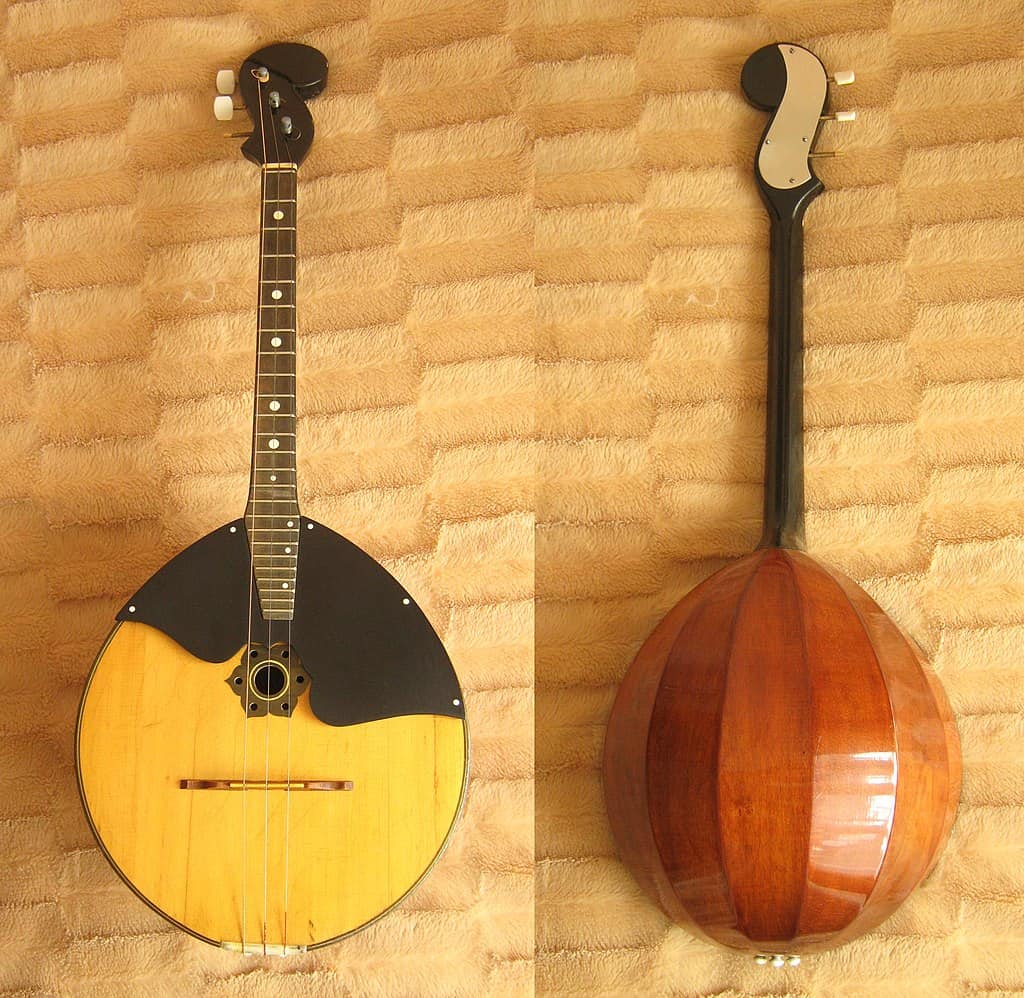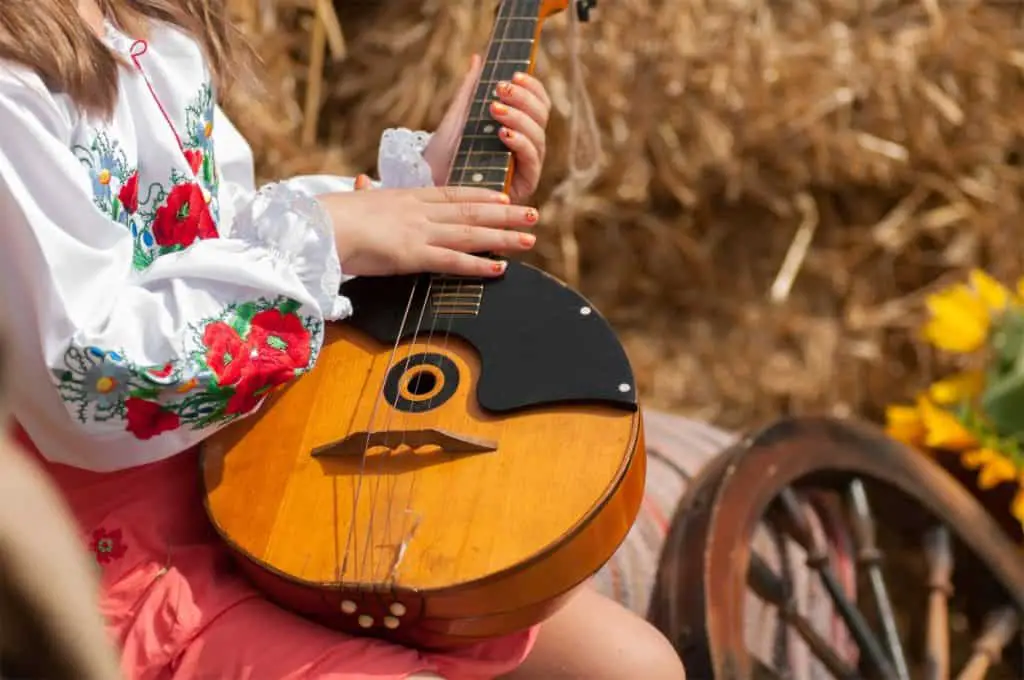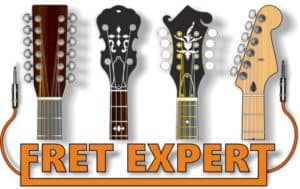If you have Russian or Ukrainian ancestry or have a keen interest in unusual fretted musical instruments, the domra may well have crossed your path at some point.
The domra is a member of the long-necked lute family of instruments and has two distinct family lines: The Russian 3-stringed variety and the 4-stringed Ukrainian.
Much like the mandolin, violin and ukulele families, the domra comes in a range of different sizes and pitches, with the commonest being the Prima (tuned E-A-D and G-D-A-E respectively for the two types, from low to high).
Tip: If you already have a Domra, check out my article on Domra Tuning and Chords, for both the 3-string and the 4-string.
In essence, you could compare the 3-stringed model with its fellow Russian Instrument, the balalaika (bal-al-lie-ka) as it also has three strings. Whereas the 4-stringed model is more closely allied with the mandolin (it shares the same G-D-A-E tuning). More on these comparisons are addressed later.
Covered in this Article:
A Brief History of the Domra
The history of the domra in its modern form dates back to 1896 and follows a strange story regarding a student of the Russian folk music pioneer, Vasily Vasilievich Andreyev.
According to popular modern folklore, the unnamed student came across an unusual circular-bodied instrument in a stable. Quite why or how it ended up there is lost to the mists of time, but he or she delivered it into the hands of Andreyev, who resurrected it to become the instrument we know today.
It’s unclear whether this tale has been embellished to add to the mystique and folky quality surrounding the instrument. Or maybe it indeed holds a few grains of truth? In all likelihood, we’ll probably never know!
It’s surely no coincidence that Andreyev was also at the forefront of the modern-day development and standardization of the balalaika, along with violin maker, Vladimir Ivanov.
The gleaned knowledge was obviously transplanted into the design of the domra and the end result produced the much loved hybrid instruments that are prevalent in today’s Russian folk music.
The 4-string model appeared just a handful of years later in 1905 after being developed by Russian instrument makers, Gregory Liubimov and Sergey Burov.
Liubimov clearly took his inspiration from the Southern European mandolin with respect of the tuning and paired it with the popularity of the newly arrived 3-string instrument.
Technically, the so-called Ukrainian 4-string domra should more accurately be called the Russian 4-string domra, but its widespread use in The Ukraine and Belarus has led to the epithet sticking.
The 3-string model hasn’t really spread beyond the borders of Russia, except in western-based balalaika and domra orchestras and ensembles who recreate traditional folk music.

The Modern Domra Player
That leads neatly onto the place the domra holds into today’s music scene. Although it is just as at home as a solo instrument or in ensembles of varying sizes, the domra can be seen as an intrinsic part of larger Russian folk and classical music orchestras, which also include balalaikas, guslis (a type of Russian zither), bayans (Russian accordion), oboes, flutes and mixed percussion.
The orchestra will typically play a combination of traditional folk and classical music, along with a selection of works by modern-day composers.
Russian folk music orchestral ensembles are also very active in parts of The United States including Los Angeles, Atlanta, Chicago, Houston, and Washington among others.
Much like many other fretted instruments, the domra is generally played with a pick (or plectrum), although fingerstyle players are also not uncommon.
In the orchestra, the domra tends to play the lead solo parts, with the accompaniment from the other members including the balalaika players.
In the Russian Cyrillic language, the word domra is spelled ‘домра’.
Tip: If you’re thinking of getting a domra, then you’ll be interested in my article on where to buy domras, and who the best luthiers are.
Domra Construction: What is a Domra Made Of?
The construction of the ribbed back on the domra involves bending the strips of wood over a hot press and gluing them in place around a solid bowl-shaped mold.
After the glue has set, the back is sanded on the outside and then removed from the mold, to be finished on the inside.
Bracing is then attached around the inner rim of the back and end block (where the neck will sit). A slot is then cut in the end block and the neck is glued and slotted in.
To get the correct shape for the top (or soundboard) of the instrument, the back is placed open side down on a thin sheet of spruce or other suitable tonewood and used as a template.
This is then drawn around and the shape of the top cut out on a bandsaw. Before the top is attached to the body, bracing is added underneath and the soundhole and rosette cut out and applied. The top and is then glued on to the rim bracing of body and bound tightly until the glue has dried.
After the setting period is over, the top and body are finished off with a channel cut out for the decorative purfling around the top edge.
The neck receives its finishes touches to accept the hardwood fingerboard and is glued in place. Further work is done to shape the heel block where the neck joins the body and the fingerboard is slotted at specific intervals to receive the frets. The fret wire is slotted into the grooves, trimmed for size and then dressed to remove any sharp edges.
Before the neck is glued into place, the headstock has holes drilled at equidistant intervals to receive the tuning pegs. These are then screwed into the back of the headstock and the whole instrument receives its finishing touches including stain, lacquer, and polish.
The tailpiece is screwed into the bottom of the instrument to receive the strings and a black scratchplate is attached to the top (4-stringed models don’t always include a scratchplate). Just below the tailpiece, metal pins are inserted into the body and a floating wooden bridge is positioned underneath the strings.
To see this whole process in action, there’s a fascinating video featuring Russian master luthier, Evgeny Serjantov:
Domra Woods and Other Materials
Domras are made with the following:
Top: Spruce
Body: Maple, sapele (sap-pee-lee), mahogany and walnut
Neck: Maple or mahogany
Fingerboard: Rosewood, ebony or acacia
Fret Markers: Mother of pearl
Nut: Bone
Domra v Balalaika: What’s the Difference?
The most obvious differences between the domra and balalaika concern the unique design of the bodies.
The domra has an unmistakable circular body and the balalaika has an instantly recognizable triangular shape.
As with any musical instrument, the way the sound reverberates within the sound chamber or body and out through the soundhole dictates the color of the sound.
Generally, the bigger the body, the louder and more resonant it’s likely to be. Other factors include the use of specific tonewoods and the internal bracing within the body.
The backs of both instruments are ribbed in a series of wooden strips that are glued together. A standard domra will generally feature seven strips and a balalaika anywhere between three and nine.
The headstock of a balalaika is designed like an upsidedown trapezoid, whereas the 3-string domra’s headstock resembles Leo Fender’s famous Stratocaster guitar shape (possibly where his inspiration originated). Generally, the 4-string has an open design, much like the headstock of a classical guitar.
Both instruments don’t have a set number of frets, but it’s common for most to feature between 19 and 24 frets (but sometimes as many as 28). The highest frets tend to be only half frets which extend into the body of the instrument.
String-wise, domras never feature paired or unison strings, whereas, this is not uncommon in some models of balalaika (not that popular with purists!).

Domra v Mandolin: What’s the Difference?
Both types of domra (the 3 and 4 string) share a similar method of construction as a traditional Neopolitan Mandolin, which also features a ribbed back made up of several strips of wood.
The main difference between a domra and mandolin is that the mandolin’s back has a deeper bowl shape. Modern Celtic mandolins don’t feature the deeper bowl and bluegrass F and A style models are even flatter. Only the Neopolitan mandolins tend to play the classical repertoire, with the others more suited to folk and bluegrass music.
The standard or prima 4-string domra may be tuned like a mandolin (G-D-A-E), but the similarity ends there. The mandolin always features unison or paired strings (except on the occasional electric model). The 3-string model has nothing in common with it, tuning-wise.
The 4-string alto domra (the second most popular model) is tuned like a mandola (or tenor mandola in European parlance). The two instruments are tuned C-G-D-A.
The 4-string tenor domra is tuned like the octave mandolin, an octave below the standard mandolin and prima domra (G-D-A-E)
The 4-string bass domra has more in common with the mandocello, which is an octave lower than the mandola and alto domra (C-G-D-A).
The 4-String Contra-Bass domra is tuned like a bass guitar or u-bass (bass ukulele) (E-A-D-G).
Some adventurous mandolin players have adopted the 4-string domra as a second instrument to add a different sound to their music. The chords are identical and both tend to be played with a pick.
What Does a Domra Sound Like?
Here are some good examples of domras being played, to give you an idea of the sound.
Domra virtuoso Peter Omelchenko playing a variety of different music :
and a more candid video of an old lady playing hers, on the streets of Russia!
If you’re interested in domras, you may also like:
- This article on the best places to buy a domra (and strings for it)
- My guide to tuning a domra and some basic chords, too.
